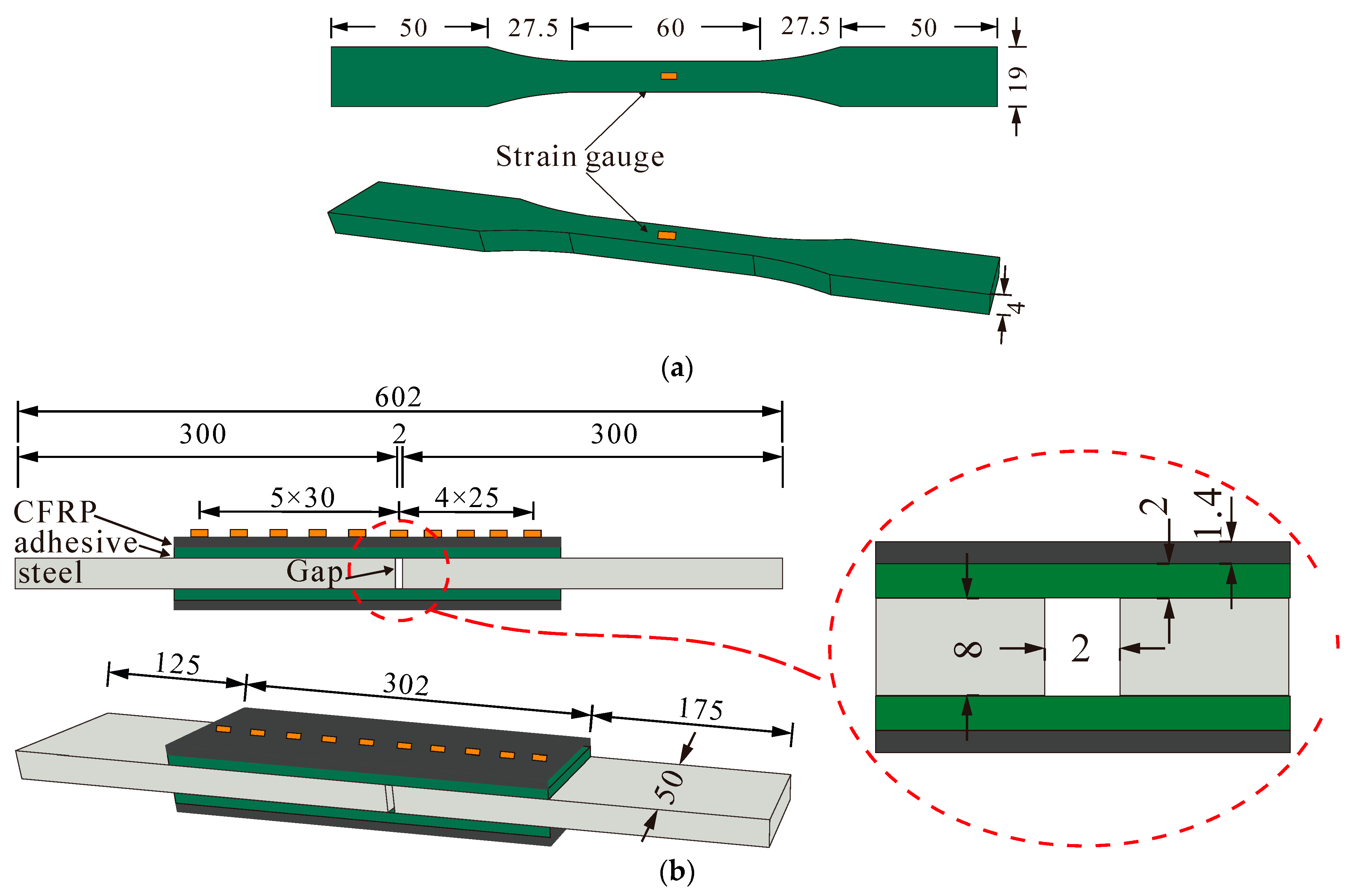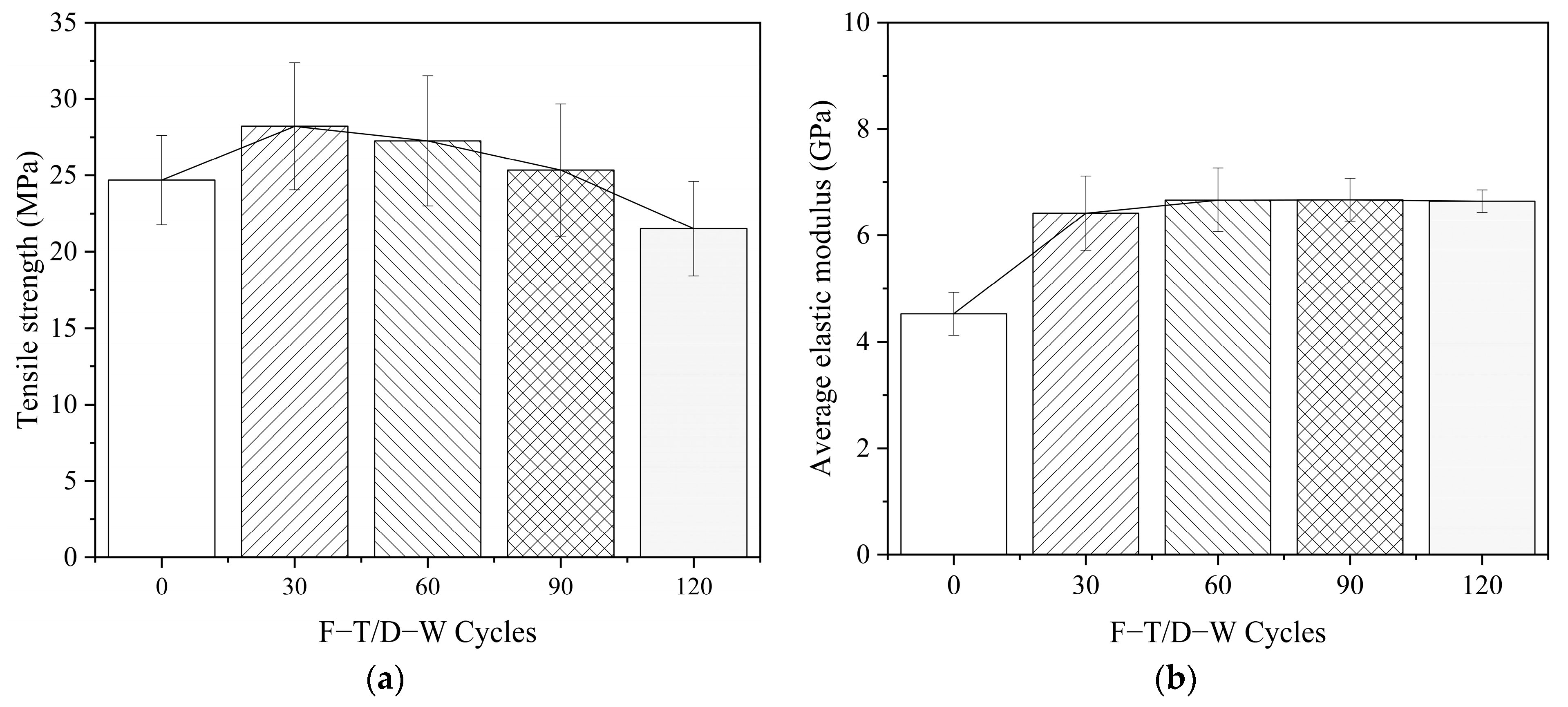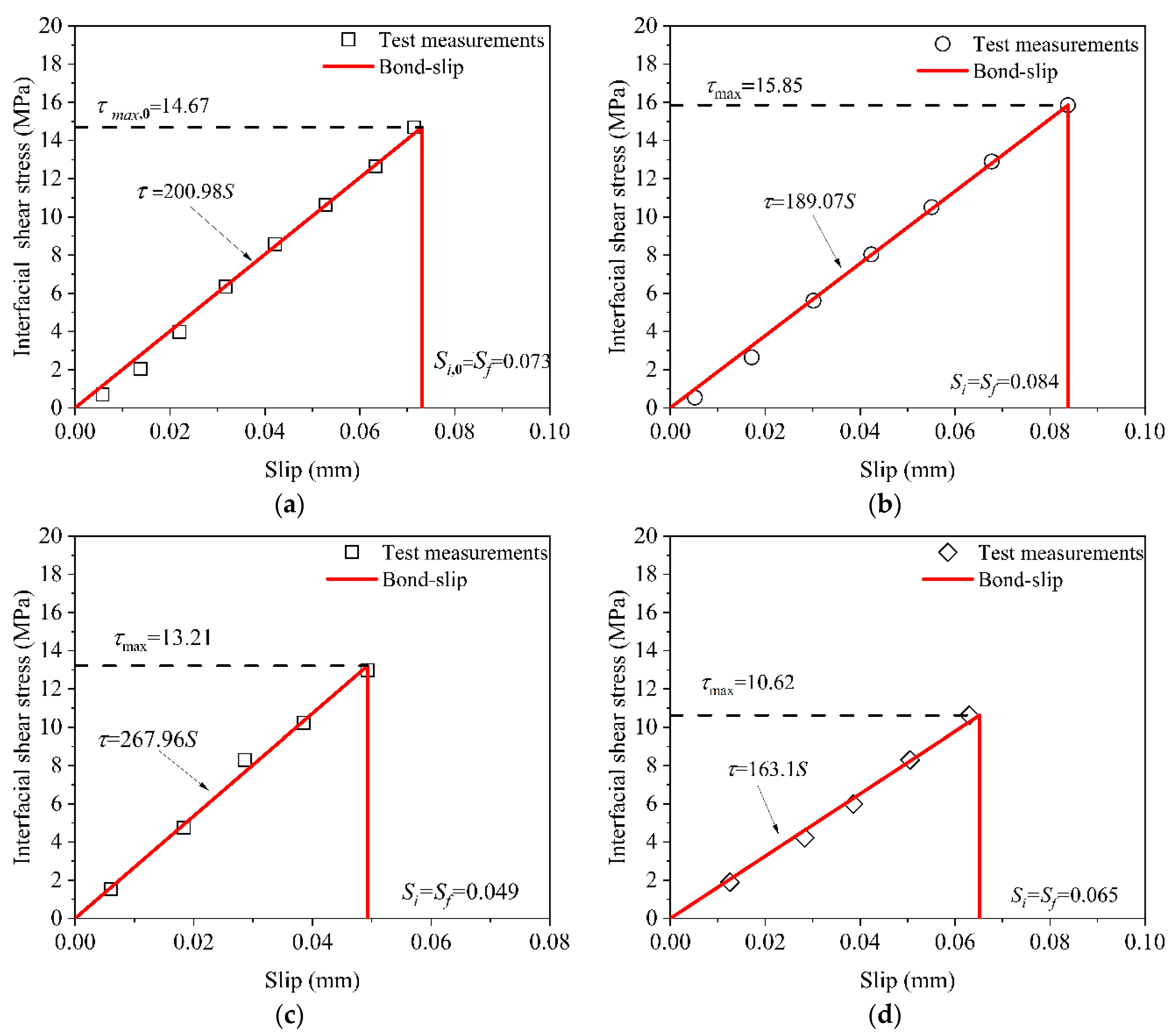Durability of CFRP–Steel Double–Lap Joints under Cyclic Freeze–Thaw/Wet–Dry Conditions
Abstract
:1. Introduction
2. Experimental Program
2.1. Material Properties
2.2. Specimens and Test Procedures
2.2.1. ERA
2.2.2. Bonded Joints
2.2.3. Specimen Preparation
2.2.4. Environmental Condition
2.2.5. Test Setup and Procedure
3. Experimental Results
3.1. ERA Specimen
3.1.1. Failure Modes
3.1.2. Ultimate Load and Peak Strain
3.2. Bonded Joints
3.2.1. Failure Modes
3.2.2. Ultimate Load and Peak Strain
4. Discussion
4.1. ERA Specimen
4.1.1. Stress–Strain Relationship Curve
4.1.2. Strength and Elastic Modulus of the ERA
4.2. Bonded Joints
4.2.1. Surface Strain Distribution
4.2.2. Bond-Slip Relationship
5. Interfacial Bond-Slip Degradation Relationship
5.1. Interfacial Bond-Slip Parameters
5.2. Degradation Models of Interfacial Bond-Slip Parameters
5.3. Bond-Slip Degradation Relationship
6. Conclusions
Author Contributions
Funding
Institutional Review Board Statement
Informed Consent Statement
Data Availability Statement
Conflicts of Interest
References
- Zhang, Q.H.; Cui, C.; Bu, Y.Z.; Li, Q.; Xia, S. State-of-the-Art Review of Fatigue of Steel Bridge in 2019. J. Civ. Environ. Eng. 2020, 42, 147–158. [Google Scholar]
- Ma, J.; Syn, S.; Yang, Q. Edition of China of Highway and Transport. Review on China’s Bridge Engineering Research: 2021. China J. Highw. Transp. 2021, 34, 1–97. [Google Scholar]
- Zheng, Y.; Ye, L.P.; Yue, Q.R. Progress in Research on Steel Structures Strengthened with CFRP. Ind. Constr. 2005, 35, 20–25. [Google Scholar] [CrossRef]
- Cheng, L.; Feng, P.; Xu, S.H.; Meng, X.M. The Technology and Research of Steel Structure Strengthened with CFRP. FRP/CM 2013, 58–63. Available online: http://en.cnki.com.cn/Article_en/CJFDTOTAL-BLGF2013Z1014.htm (accessed on 17 July 2022).
- Dong, S.E.; Ma, M.L.; Wang, Y.H. The Analysis of Parametric and Reinforcement Coefficient about H-Section Steel Beams Reinforced by Prestressed CFRP Plates. FRP/CM 2019, 17–25. Available online: http://en.cnki.com.cn/Article_en/CJFDTotal-BLGF201904003.htm (accessed on 17 July 2022).
- Liu, Y.; Zwingmann, B.; Schlaich, M. Carbon Fiber Reinforced Polymer for Cable Structures—A Review. Polymers 2015, 7, 2078. [Google Scholar] [CrossRef] [Green Version]
- Peng, H.; Chou, J.X.; Sun, Y.; Zhang, J.R.; Gong, S. Bond Behavior of Near-Surface-Mounted CFRP to Concrete Structure. China J. Highw. Transp. 2019, 32, 156–166. [Google Scholar]
- Agarwal, A.; Foster, S.J.; Hamed, E.; Ng, T.S. Influence of Freeze-thaw Cycling on the Bond Strength of Steel–FRP Lap Joints. Compos. Part B Eng. 2014, 60, 178–185. [Google Scholar] [CrossRef]
- Ren, H.T.; Li, S.; Gao, D.Y. Bond Behaviour of CFRP and Steel under Dry–Wet Cyclic Condition and Loading. China Civ. Eng. J. 2009, 42, 36–41. [Google Scholar]
- Li, J.H.; Deng, J.; Wang, Y.; Guan, J.J.; Zheng, H.Z. Experimental Study of Notched Steel Beams Strengthened with a CFRP Plate Subjected to Overloading Fatigue and Wetting/Drying Cycles. Compos. Struct. 2019, 209, 634–643. [Google Scholar] [CrossRef]
- Borrie, D.; Liu, H.B.; Zhao, X.L.; Singh Raman, R.K.; Bai, Y. Bond Durability of Fatigued CFRP–Steel Double-lap Joints Pre–exposed to Marine Environment. Eng. Struct. 2015, 131, 799–809. [Google Scholar] [CrossRef]
- Li, H.; Xu, S.H.; Wang, Y.D.; Song, C.M. Deterioration of the Bond Behavior between CFRP and Corroded Steel in Wet–Dry Cycling Environment. Compos. Struct. 2021, 272, 114–202. [Google Scholar] [CrossRef]
- Ren, X.; Wang, Y.; Yu, X.; Sun, Y.M.; Liu, Q.F. Experimental study on the interface bond properties of CFRP–plate–steel–plate Joints in freeze–thaw/dry–wet environments. China J. Highw. Transp. 2022, 35, 247–258. [Google Scholar]
- Jiang, S.F.; Cui, E.J.; Wang, J.; Hui, Z.Z. Bond Behavior of CFRP-Concrete Interface in Chlorine Salt Solution with Wet–Dry Cycles. J. Build. Struct. 2022, 43, 265–274. [Google Scholar]
- Cabral–Fonseca, S.; Correia, J.R.; Custódio, J.; Silva, H.M.; Machado, A.M.; Sousa, J. Durability of FRP–Concrete Bonded Joints in Structural Rehabilitation: A Review. Int. J. Adhes. Adhes. 2018, 83, 153–167. [Google Scholar] [CrossRef]
- Toutanji, H.A.; Gomez, W. Durability Characteristics of Concrete Beams Externally Bonded with FRP Composite Sheets. Cem. Concr. Compos. 1997, 19, 351–358. [Google Scholar] [CrossRef]
- Di Tommaso, A.; Neubauer, U.; Pantuso, A.; Rostasy, F.S. Behavior of Adhesively Bonded Concrete–CFRP Joints at Low and High Temperatures. Mech. Compos. Mater. 2001, 37, 327–338. [Google Scholar] [CrossRef]
- Silva, P.; Fernandes, P.; Sena-Cruz, J.; Xavier, J.; Castro, F.; Soares, D.; Carneiro, V. Effects of Different Environmental Conditions on the Mechanical Characteristics of a Structural Epoxy. Compos. Part B Eng. 2016, 88, 55–63. [Google Scholar] [CrossRef] [Green Version]
- Zhang, P.; Shang, J.Q.; Fan, J.J.; Chen, Q.Z.; Zhu, H.; Gao, D.Y.; Sheikh, S.A. Experimental Study on the Bond Behavior of the CFRP Plate-ECC-Concrete Composite Interface under Freeze–Thaw Cycles. Const. Build. Mater. 2022, 316, 125822. [Google Scholar] [CrossRef]
- Wu, B.; Zhang, S.; Liu, F.T. Effects of Freeze–Thaw Cycling on Mechanical Behaviors of AFRP and Epoxy Adhesive. J. South China Univ. Technol. 2016, 44, 144–150. [Google Scholar]
- Moudood, A.; Rahman, A.; Khanlou, H.M.; Hall, W.; Öchsner, A.; Francucci, G. Environmental Effects on the Durability and the Mechanical Performance of Flax Fiber/Bio–Epoxy Composites. Compos. Part B Eng. 2019, 171, 284–293. [Google Scholar] [CrossRef]
- Shi, J.W.; Zhu, H.; Gang, W.; Wu, Z.S. Tensile Behavior of FRP and Hybrid FRP Sheets in Freeze–Thaw Cycling Environments. Compos. Part B Eng. 2014, 60, 239–247. [Google Scholar] [CrossRef]
- Pang, Y.Y.; Wu, G.; Wang, H.T.; Liu, Y. Interfacial Bond–Slip Degradation Relationship between CFRP Plate and Steel Plate under Freeze–Thaw cycles. Constr. Build. Mater. 2019, 214, 242–253. [Google Scholar] [CrossRef]
- Hua, D.; Lin, J.; Zhang, B. Effects of Salt Spray on the Mechanical Properties of Aluminum–Epoxy Adhesive Joints. J. Adhes. Sci. Technol. 2013, 27, 1580–1589. [Google Scholar] [CrossRef]
- Nguyen, T.C.; Bai, Y.; Zhao, X.L.; Ai–Mahaidi, R. Durability of Steel/CFRP Double Strap Joints Exposed to Sea Water, Cyclic Temperature and Humidity. Compos. Struct. 2012, 94, 1834–1845. [Google Scholar] [CrossRef]
- Karbhari, V.M.; Chin, J.W.; Hunston, D.; Benmokrane, B. Durability Gap Analysis for Fiber-Reinforced Polymer Composites in Civil Infrastructure. J. Compos. Constr. 2003, 7, 238–247. [Google Scholar] [CrossRef] [Green Version]
- Xie, J.H.; Lu, Z.Y.; Guo, Y.C.; Huang, Y.H. Durability of CFRP Sheets and Epoxy Resin Exposed to Natural Hygrothermal or Cyclic Wet–Dry Environment. Polym. Compos. 2019, 40, 553–567. [Google Scholar] [CrossRef]
- Yang, Q.; Xian, G.; Karbhari, V.M. Hygrothermal Ageing of an Epoxy Adhesive Used in FRP Strengthening of Concrete. J. Appl. Polym. Sci. 2008, 107, 2607–2617. [Google Scholar] [CrossRef]
- Sousa, J.M.; Correia, J.R.; Cabral-Fonseca, S. Durability of an Epoxy Adhesive Used in Civil Structural Applications. Constr. Build. Mater. 2018, 161, 618–633. [Google Scholar] [CrossRef]
- Heshmati, M.; Haghani, R.; Ai–Emrani, M. Durability of Bonded FRP-to-Steel Joints: Effects of Moisture, De-icing Salt Solution, Temperature and FRP Type. Compos. Part B Eng. 2017, 119, 153–167. [Google Scholar] [CrossRef] [Green Version]
- Xie, W.Z.; Deng, J.; Li, S. Tensile Bearing Capacity of Steel–CFRP strap joints under Dry–Wet Cycles. Ind. Constr. 2015, 45, 27–30. [Google Scholar]
- Dawood, M.; Rizkalla, S. Environmental Durability of a CFRP System for Strengthening Steel Structures. Constr. Build. Mater. 2010, 24, 1682–1689. [Google Scholar] [CrossRef]
- Ren, X.; Sherif, M.M.; Wei, Y.Y.; Lyu, Y.H.; Sun, Y.M.; Ozbulut, E.O. Effect of corrosion on the tensile and fatigue performance of CFRP strand Sheet/Steel double strap joints. Eng. Struct. 2022, 260, 114240. [Google Scholar] [CrossRef]
- Wei, F.F.; Zhu, D.C.; Wang, H.T.; Bian, Z.N. Experimental Study on Bond Behavior of CFRP Plate–Steel Interface in Freeze–Thaw Environment. J. Southeast Univ. 2020, 50, 803–807. [Google Scholar]
- Yang, Y.G.; Silva, M.A.G.; Biscaia, H.; Chastre, C. Bond Durability of CERP Laminates-to-Steel Joints Subjected to Freeze–Thaw. Compos. Struct. 2019, 212, 243–258. [Google Scholar] [CrossRef]
- Heshmati, M.; Haghani, R.; Al–Emrani, M. Durability of CFRP/steel Joints under Cyclic Wet–Dry and Freeze–Thaw Conditions. Compos. Part B Eng. 2017, 126, 211–226. [Google Scholar] [CrossRef]
- Kim, Y.J.; Hossain, M.; Yoshitake, I. Cold Region Durability of a Two-Part Epoxy Adhesive in Double-Lap Shear Joints: Experiment and Model Development. Constr. Build. Mater. 2012, 36, 295–304. [Google Scholar] [CrossRef]
- GB/T 51355; Durability Assessment Standard of Existing Concrete Structures. National Standard of the People’s Republic of China: Beijing, China, 2019.
- GB 50017; Steel Structure Design Standard. National Standard of the People’s Republic of China: Beijing, China, 2017.
- GB/T 2567; Test Methods for Properties of Resin Casting Boby. National Standard of the People’s Republic of China: Beijing, China, 2008.
- D638-10; Standard Test Method for Tensile Properties of Plastics. ASTM International: West Conshohocken, PA, USA, 2010.
- Schnerch, D.; Dawood, D.; RizkAalla, S.; Sumeer, E. Proposed design guidelines for strengthening of steel bridges with FRP materials. Constr. Build. Mater. 2007, 21, 1001–1010. [Google Scholar] [CrossRef]
- Spaggiari, A.; Dragoni, E. Effect of mechanical surface treatment on the static strength of adhesive lap joints. J. Adhes. 2013, 89, 677–696. [Google Scholar] [CrossRef]
- GB/T 50082; Standard for Test Method of Long-Term Performance and Durability of Ordinary Concrete. National Standard of the People’s Republic of China: Beijing, China, 2009.
- Chen, T.; Wang, X.; Qi, M. Fatigue improvements of cracked rectangular hollow section steel beams strengthened with CFRP plates. Thin Walled Struct. 2018, 122, 371–377. [Google Scholar] [CrossRef]
- Bocciarelli, M.; Colombi, P.; Fava, G.; Poggi, C. Prediction of debonding strength of tensile steel/CFRP joints using fracture mechanics and stress based criteria. Eng. Fract. Mech. 2009, 76, 299–313. [Google Scholar] [CrossRef]
- Xia, S.H.; Teng, J.G. Behaviour of FRP-to-steel bonded joints. In Proceedings of the International Symposium on Bond Behaviour of FRP in Structures, Hong Kong, China, 7–9 December 2005; International Institute for FRP in Construction: Brussels, Belgium, 2005; pp. 411–418. [Google Scholar]
- Narmashiri, K.; Sulong, N.H.R.; Jumaat, M.Z. Failure analysis and structural behaviour of CFRP strengthened steel I-beams. Constr. Build. Mater. 2012, 30, 1–9. [Google Scholar] [CrossRef]
- Li, C.X.; Cao, X.H.; Ke, L.; Luo, N.H.; Guo, L.C. Effect of high temperature on mechanical properties of epoxy adhesive for structural reinforcement. J. Build. Mater. 2020, 23, 642–649. [Google Scholar]
- He, J.; Xian, G.J. Debonding of CFRP-to-steel joints with CFRP delamination. Compos. Struct. 2016, 153, 12–20. [Google Scholar] [CrossRef]
- Wu, C.; Zhao, X.; Duan, W.H.; Al–Mahaidi, R. Bond characteristics between ultra high modulus CFRP laminates and steel. Thin Wall Struct. 2012, 51, 147–157. [Google Scholar] [CrossRef]
- Yu, T.; Fernando, D.; Teng, J.G.; Zhao, X.L. Experimental study on CFRP-to-steel bonded interfaces. Compos. Part B Eng. 2012, 43, 2279–2289. [Google Scholar] [CrossRef]
- Fernando, D.; Yu, T.; Teng, J.G.; Asce, M. Behavior of CFRP Laminates Bonded to a Steel Substrate Using a Ductile Adhesive. J. Compos. Constr. 2014, 18, 04013040. [Google Scholar] [CrossRef]












| Material Type | Tensile Strength (MPa) | Tensile Modulus (GPa) | Elongation Break (%) | Shear Strength (MPa) |
|---|---|---|---|---|
| CFRP | 2400 | 160 | 1.65 | 50.5 |
| ERA | 30.3 | 4.92 | 1.62 | / |
| Steel | 455 | 206 | / | / |
| Specimen Number | Ultimate Load (kN) | Mean Value (kN)/SD | Peak Strain (με) | Mean Value (με)/SD |
|---|---|---|---|---|
| C0–1 | 0.94 | 0.94/±0.04 | 3433 | 3930/±418 |
| C0–2 | 0.99 | 4457 | ||
| C0–2 | 0.90 | 3899 | ||
| FT/DW30–1 | 1.29 | 1.36/±0.05 | 9629 | 9712/±84 |
| FT/DW30–2 | 1.37 | 9827 | ||
| FT/DW30–3 | 1.42 | 9680 | ||
| FT/DW60–1 | 1.31 | 1.32/±0.07 | 4064 | 4880/±1498 |
| FT/DW60–2 | 1.41 | 6982 | ||
| FT/DW60–3 | 1.24 | 3596 | ||
| FT/DW90–1 | 1.19 | 1.23/±0.04 | 5310 | 5344/±48 |
| FT/DW90–2 | 1.22 | 5412 | ||
| FT/DW90–3 | 1.28 | 5311 | ||
| FT/DW120–1 | 0.66 | 0.77/±0.12 | 4082 | 3885/±377 |
| FT/DW120–2 | 0.93 | 4215 | ||
| FT/DW120–3 | 0.72 | 3357 |
| Specimen No. | Ultimate Load (kN) | Mean Value (kN)/SD | Peak Strain (με) | Mean Value (με)/SD | Failure Mode |
|---|---|---|---|---|---|
| C–0–1 | 75.0 | 74.0/±1.4 | 2252 | 2338/±86 | A + C |
| C–0–2 | 73.0 | 2424 | A + C | ||
| FT30–DW30–1 | 68.8 | 67.0/±4.5 | 2769 | 2487/±327 | A + C + E |
| FT30–DW30–2 | 60.9 | 2028 | A + C + E | ||
| FT30–DW30–3 | 71.4 | 2664 | A + C | ||
| FT60–DW60–1 | 40.0 | 45.0/±4.5 | 1614 | 1741/±101 | A + C |
| FT60–DW60–2 | 44.2 | 1862 | A + C | ||
| FT60–DW60–3 | 50.9 | 1746 | A + C + E | ||
| FT90–DW90–1 | 44.1 | 45.4/±1.4 | 2025 | 2286/±261 | A + C |
| FT90–DW90–2 | 30.2 | 366 | A + C | ||
| FT90–DW90–3 | 46.7 | 2546 | A + C | ||
| FT120–DW120–1 | 28.2 | 31.1/±3.0 | 1894 | 2119/±169 | A + C |
| FT120–DW120–2 | 48.3 | 2161 | A + C | ||
| FT120–DW120–3 | 34.1 | 2302 | A + C |
| Specimen Number | Average Value of Ultimate Load (kN) | ||||
|---|---|---|---|---|---|
| MP–FT–DW–0 | 14.67 | 0.073 | 0.073 | 0.54 | 74.0 |
| MP–FT–DW–30 | 15.85 | 0.084 | 0.084 | 0.67 | 67.0 |
| MP–FT–DW–60 | 13.21 | 0.049 | 0.049 | 0.32 | 45.0 |
| MP–FT–DW–90 | 10.62 | 0.065 | 0.065 | 0.35 | 45.4 |
| MP–FT–DW–120 | 8.04 | 0.024 | 0.064 | 0.10 | 31.1 |
| Bond-Slip Parameter | a | b | c |
|---|---|---|---|
| 0.0031 | / | / | |
| / | 6.3414 × 10−5 | −0.0024 | |
| / | 7.3647 × 10−5 | −0.0018 |
Publisher’s Note: MDPI stays neutral with regard to jurisdictional claims in published maps and institutional affiliations. |
© 2022 by the authors. Licensee MDPI, Basel, Switzerland. This article is an open access article distributed under the terms and conditions of the Creative Commons Attribution (CC BY) license (https://creativecommons.org/licenses/by/4.0/).
Share and Cite
Ren, X.; Jiang, L.; He, J.; Yang, Y.; Sun, Y.; Liu, Q.; Chen, S. Durability of CFRP–Steel Double–Lap Joints under Cyclic Freeze–Thaw/Wet–Dry Conditions. Polymers 2022, 14, 3445. https://doi.org/10.3390/polym14173445
Ren X, Jiang L, He J, Yang Y, Sun Y, Liu Q, Chen S. Durability of CFRP–Steel Double–Lap Joints under Cyclic Freeze–Thaw/Wet–Dry Conditions. Polymers. 2022; 14(17):3445. https://doi.org/10.3390/polym14173445
Chicago/Turabian StyleRen, Xiang, Lingzhi Jiang, Jun He, Yi Yang, Yamin Sun, Qunfeng Liu, and Shaojie Chen. 2022. "Durability of CFRP–Steel Double–Lap Joints under Cyclic Freeze–Thaw/Wet–Dry Conditions" Polymers 14, no. 17: 3445. https://doi.org/10.3390/polym14173445
APA StyleRen, X., Jiang, L., He, J., Yang, Y., Sun, Y., Liu, Q., & Chen, S. (2022). Durability of CFRP–Steel Double–Lap Joints under Cyclic Freeze–Thaw/Wet–Dry Conditions. Polymers, 14(17), 3445. https://doi.org/10.3390/polym14173445







